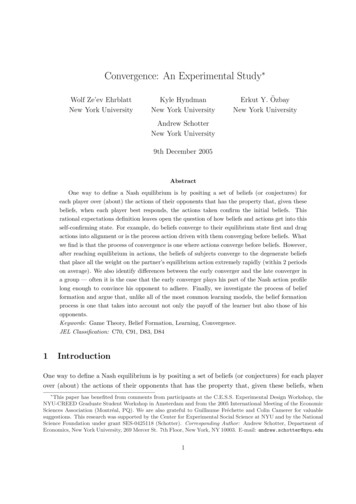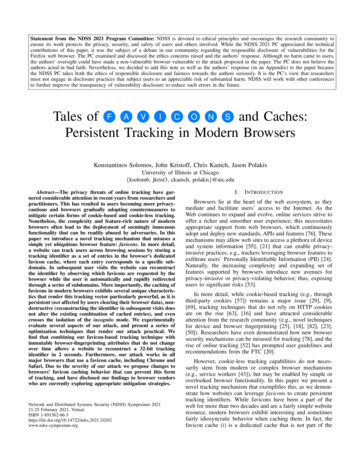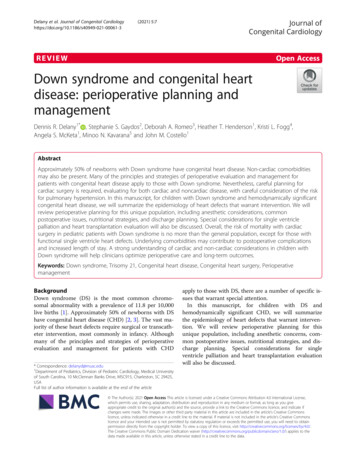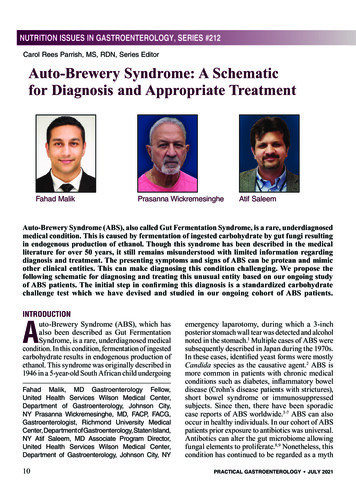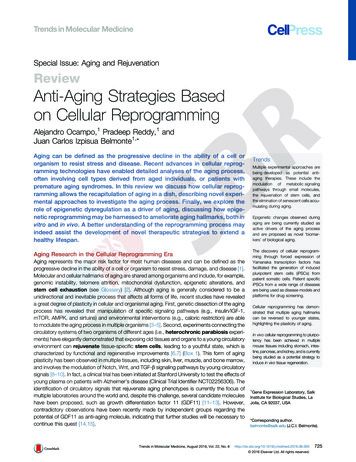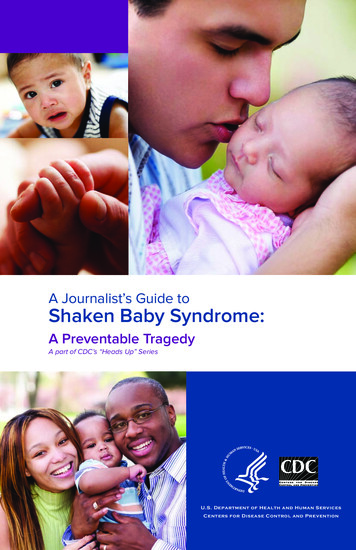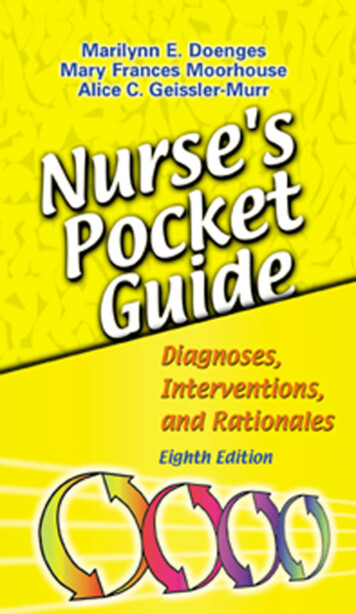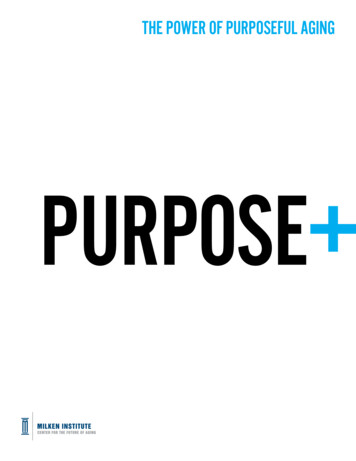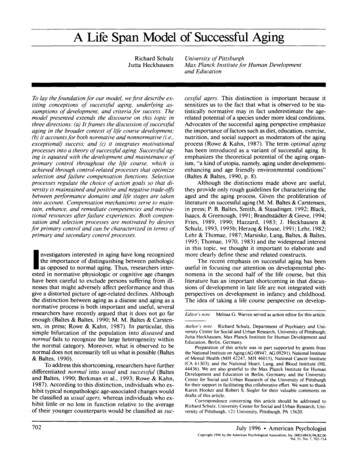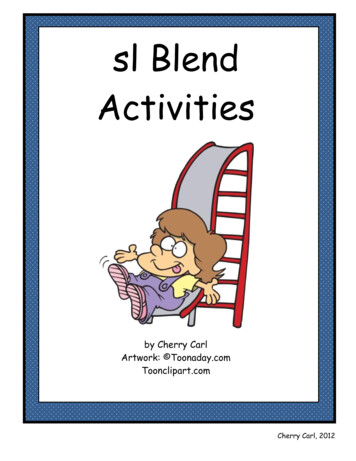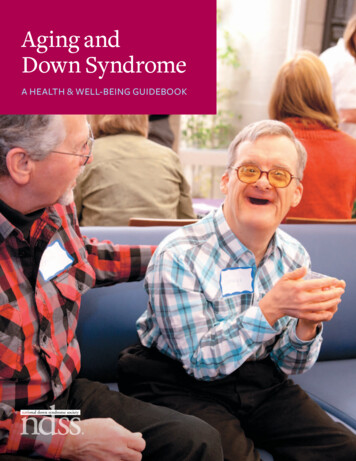
Transcription
Aging andDown SyndromeA HEALTH & WELL-BEING GUIDEBOOKwww.ndss.org1
The National Down SyndromeSociety advocates for the value,acceptance and inclusion ofpeople with Down syndrome.ImageCourtesy ofTheVictoriaWill,DownCoverSyndromeImage Courtesy2NationalSocietyof Joseph Guidi
Table of ContentsIntroduction3General Overview of Aging with Down Syndrome4Common Medical Conditions6Emotional and Psychiatric Well-Being14An Introduction to Alzheimer’s Disease16the span of alzheimer’s diseaserecognizing alzheimer’s disease1820A Caregiver’s Guide to Alzheimer’s Disease24Planning for Old Age28living environments and housingthinking about retirementcoordination of careend-of-life considerations29313238lead author julie moran, doJulie Moran is a geriatrician specializing in older adults with intellectual and developmental disabilities(I/DD). Dr. Moran is on faculty at Harvard Medical School and Beth Israel Deaconess Medical Center inBoston, MA.additional authors / contributorsDr. Moran and NDSS extend their thanks and gratitude to the dedicated working group who helpedmake this guidebook possible: Mary Hogan, MAT; Kathy Srsic-Stoehr, MSN, MS, RN; Kathy Service, NP,PhD; and Susan Rowlett, LICSW.Design by MSDS · ms-ds.comwww.ndss.org1
LOOKING AHEADPeople with Down syndromeare living longer than everbefore. Learning about commonconditions and issues encounteredin adulthood can help prepare fora healthy future.2The National Down Syndrome SocietyImage Courtesy of Trinnica
IntroductionAdults with Down syndrome are now reaching oldage on a regular basis and are commonly livinginto their 50s, 60s and 70s. While there are manyexciting milestones that accompany growing older,old age can also bring unexpected challenges forwhich adults with Down syndrome, their familiesand caregivers may not feel adequately prepared. Inorder to enjoy all the wonderful aspects of a longerlife, it is important to be proactive and learn aboutissues that may lie ahead.Adults with Down syndrome, along with their families and caregivers, needaccurate information and education about what to anticipate as a part ofgrowing older, so they can set the stage for successful aging. The purpose of thisbooklet is to help with this process. It is intended to be used by various learners:families, professionals, direct caregivers or anyone concerned with the generalwelfare of someone with Down syndrome.The goals of this booklet are as follows:xx Provide guidance, education and support to families and caregivers of olderadults with Down syndromexx Prepare families and caregivers of adults with Down syndrome for medicalissues commonly encountered in adulthoodxx Empower families and caregivers with accurate information so that they can takepositive action over the course of the lifespan of adults with Down syndromexx Provide an advocacy framework for medical and psychosocial needs commonlyencountered by individuals affected by Down syndrome as they agewww.ndss.org3
General Overview of Aging with Down SyndromeAdults with Down syndrome experience “accelerated aging,” meaning that they experience certainconditions and physical features that are common to typically aging adults at an earlier age than thegeneral population.The reason for this is not fully understood, but is largely related to genes on chromosome 21 thatare associated with the aging process. This chromosome is important because Down syndrome ischaracterized by a third full or partial copy of the21st chromosome.Generally, the experience of accelerated aging can be seen medically, physically and functionally.Many family members and caregivers commonly observe that people with Down syndromeappear to “slow down” once they enter their late 40s or 50s.Complicating this picture is that “normal aging” in adults with Down syndrome is still notcompletely understood, and therefore predicting and preparing for the aging process becomesmore challenging. This requires more attention and investigation from the medical community,but keeping eyes and ears attuned to early changes allows for responding to these changes in aproactive fashion.The next section will outline the medical and physical issues that are common with aging and willhelp point out the key issues to look for over the lifespan.4General Overview of Aging with Down Syndrome
www.ndss.org5
ACCELERATED AGINGAdults with Down syndromeexperience “accelerated aging,”meaning that in their 40s and 50sthey experience certain conditionsthat are more commonly seen in elderlyadults in the general population.6The National Down Syndrome SocietyImage Courtesy of Blair Williamson
Common Medical ConditionsThis section focuses on medical issues that are commonlyencountered in individuals with Down syndrome throughoutadulthood and into older age. These are issues to watch forover time and to ensure are being monitored by a doctor orother health care provider.Sensory LossEyes: Adults with Down syndrome are at risk of early cataracts andkeratoconus. Cataracts cause a clouding of the lens of the eye, producingblurry and impaired vision. Keratoconus causes the round cornea to becomecone shaped, which can lead to a distortion of vision. Both of these conditionscan be screened for by an eye doctor and should be assessed regularly.Ears: Adults with Down syndrome are at high risk for conductive hearing loss.In addition, they tend to have small ear canals and frequently can have ear wax impactions thatcan impair hearing. Routine ear examinations can assess wax impactions, and periodic screeningwith an audiologist can formally assess hearing loss.Undiagnosed sensory impairments (vision or hearing) are frequently mistaken as stubbornness,confusion or disorientation in adults with Down syndrome. These conditions are quite commonand, when properly identified, can be greatly improved with glasses, hearing aids, ear cleaningsand environmental adaptations.take home points Screen for vision and hearing impairment and get regular exams to assessoverall eye and ear health. Check for ear wax impactions and request formal audiology testing to detect hearing loss.www.ndss.org7
HypothyroidismThe thyroid gland is involved in various metabolic processes controllinghow quickly the body uses energy, makes proteins and regulates hormones.Thyroid dysfunction is common in adults with Down syndrome and can lead tosymptoms of fatigue, mental sluggishness, weight fluctuations and irritability.Thyroid dysfunction is easily detected via a screening blood test that can beperformed by a primary care doctor, and treatment will usually involve takingthyroid medication that regulates abnormal hormone levels.take home points Test for thyroid abnormalities periodically through screenings and blood tests. Discuss screening with the primary care doctor and consider checking for thyroid dysfunctionif new symptoms of sleepiness, confusion or mood changes occur.Obstructive Sleep ApneaAdults with Down syndrome are at increased risk for sleep apnea, a sleepdisorder that leads to poor quality, non-restorative sleep. Signs of possiblesleep apnea include snoring, gasping noises, daytime sleepiness, morningfatigue (difficulty getting out of bed), excessive napping and fragmented sleep.Undiagnosed or untreated sleep apnea leads to symptoms of irritability, poorconcentration, behavior changes and impaired attention. It also can put a strainon the heart and lungs and cause high blood pressure. Sleep apnea can be detected via a sleepstudy performed at a sleep lab. In some cases, sleep testing can be arranged in the home.take home points Sleep apnea is common and can frequently go undetected in adults with Down syndrome. Monitor sleep patterns, particularly if there is a change in mood, behavior or ability to concentrate. Discuss concerns with a primary care doctor to see if a sleep study is necessary.8Common Medical Conditions
OsteoarthritisPeople with Down syndrome are typically hyperflexible. Over the years theycan put increased wear-and-tear on their large joints (hips, knees, etc.). Thisleads to increased risk of osteoarthritis. Adults who are overweight or whowere previously overweight are at increased risk. Arthritis is painful andcan lead to decreased mobility and decreased willingness to participate inactivities. For some individuals, the pain can express itself through negativebehavioral changes. Untreated pain increases the risk of further immobility and deconditioningdue to reluctance to participate in activities or exercise.take home points Pay attention to changes in walking or activity level, looking for signs of stiffness or discomfort. Keep in mind that many adults with Down syndrome may under-report pain or appear to havea high pain tolerance. If pain is suspected, discuss the possibility of underlying arthritis with theprimary care doctor.www.ndss.org9
Atlantoaxial Instability and Cervical Spine ConcernsThe region of the spine located in the neck is called the cervical spine. Inadults with Down syndrome, there is increased risk of instability betweenthe the “atlas” and the “axis,” the first and second spinal bones in the cervicalspine that are located directly below the base of the head. This is known asatlantoaxial instability. If instability is present and arthritis changes occur in thespine, there is increased risk of damage to the spinal cord in that region.A gradual narrowing of the spinal canal may also occur due to development of severe arthriticchanges in the bones of the spine. This is called spinal stenosis.When chronic changes occur in the cervical spine that affect the spinal cord, symptoms includingweakness in the arms or hands, walking abnormalities or incontinence may be observed.take home points Remain mindful that the bones of the neck are more vulnerable as adults with Downsyndrome grow older. Further imaging or referral to a specialist may be necessary if new symptoms occur. A screening cervical spine x-ray is generally recommended at least once during adulthood.OsteoporosisOsteoporosis causes a thinning of bone mass that leads to risk of fracture.People with Down syndrome are at higher risk for disease, especially if there isimmobility, low body mass, family history of osteoporosis, early menopauseor longtime exposure to certain anti-seizure medications. Osteoporosis isscreened for via a bone density test and can be treated through medication, aswell as other exercise and lifestyle modifications.take home point Talk to the primary care doctor about screening bone density tests, particularly if there areadditional risk factors.10Common Medical Conditions
Image Courtesy of Jamie KaplanCeliac DiseaseCeliac disease is a condition where one’s body cannot digest wheat gluten andwheat products, causing damage to the lining of the intestine and preventingabsorption of certain nutrients.When celiac disease is present it can cause gastrointestinal distress,nutritional deficiencies and sometimes general irritability or behaviorchanges. There is a higher risk of this condition in individuals with Down syndrome.Celiac disease can be screened for by a blood test but requires a biopsy and evaluation of the smallintestine to confirm the diagnosis. A visit with a gastroenterology specialist is usually necessary toformally make the diagnosis. Celiac disease is usually primarily treated with a wheat-free diet.take home points Consider the possibility of celiac disease when there is weight loss, poor nutrition or persistentchanges in bowel habits. Talk to the primary care doctor about the increased risk of celiac disease and, if it was neverperformed in adulthood, consider a screening blood test.Alzheimer’s DiseaseEarly-onset Alzheimer’s disease is more common in adults with Downsyndrome than in the general population. It is important to be aware ofthe connection between Down syndrome and Alzheimer’s disease sothat proper surveillance can be done to look for signs or symptoms of thedisease. This topic will be discussed in detail in another section.www.ndss.org11
Medication and Prescription ConsiderationsThe purpose of this section is to review general principles to keep in mind with regard to medication. It is beyond the scope and purpose of this document to discuss specific medications ortreatments. Please be sure to review any specific medication questions with your physician.As individuals grow older, they often acquire multiple doctors and specialists. While it is commonfor several doctors to be involved in prescribing medications for one individual, they may not becommunicating with one another at all. It is important to be proactive with management of themedication list, making sure that both prescriptions and over-the-counter drugs, along with theirdoses and frequencies, are up to date.As a general rule, it is advisable to start new medications at a low dose and slowly increase themif necessary. Be sure to understand why a medication is being recommended and inquire aboutside effects. Avoid making multiple medication changes at once or starting or adjusting twomedications at the same time. Changing or adding one thing at a time allows for a clearer pictureof the impact of the medication on its own. All medications, including over-the-counter andherbal medications, should be periodically reviewed, especially with the primary care doctor attimes of transition (leaving the hospital, transferring to a new living situation, etc.).take home points A periodic review of the medication list is essential. When reviewing the medication list, consider: Is each medication necessary? Do the benefits ofeach medication outweigh the risks of side effects? Is there room to simplify? Always think of medications when observing a new change in mood, behavior or physicalsymptoms. Was a new prescription just started? A dose increased? A medication suddenlydiscontinued?12Common Medical Conditions
MANAGING MEDICAL HISTORYWith aging, adults with Downsyndrome may acquire variousdoctors and specialists, each ofwhom may make medicationrecommendations or adjustments.Often the various prescribers are notin direct contact with one another, soit is critical to carefully oversee themedication list.www.ndss.org13
ImageCourtesy ofTheDennisWilkes/ OrangeGroveSocietyCenter14NationalDownSyndrome
Emotional and Psychiatric Well-BeingAs adults with Down syndrome grow older, there isincreased risk of experiencing certain common mentalhealth disorders like depression, anxiety, obsessivecompulsive disorder and behavioral disturbances. A suddenor abrupt change in mood or behavior patterns warrantsfurther investigation. A thorough medical assessmentis recommended to look for any new (and potentiallycorrectable) physical or medical conditions that may becontributing to the change in behavior or mood.Psychiatric illnesses can have different features in adults with Down syndrome, thus anevaluation from a mental health provider with special training or expertise in adults withintellectual disabilities is recommended. In addition to medical and psychological contributorsto mood changes, it is important to be sensitive to any significant change in environmentor social structure. Pay attention to any recent emotional upheavals that the individual mayhave experienced, including loss of a parent, loss of a housemate, departure of a belovedstaff member, conflict at the workplace, etc. The effects of these changes should not beunderestimated as individuals may experience great difficulty coping.take home points People with Down syndrome can have psychiatric illness (depression, anxiety, etc.) just likeanyone else. Monitor closely when there is a significant change in mood or behavior and seek attention from aprimary care doctor or mental health specialist if features persist or interfere with day-to-day life. Don’t overlook other new medical or physical issues that may be contributing to these changes. Pay attention to any other situational changes that may also trigger or exacerbate sadness,anxiety, etc.www.ndss.org15
A THOUGHTFUL APPROACHAdults with Down syndrome are atincreased risk of Alzheimer’s diseaseas they grow older, but Alzheimer’sdisease is not inevitable. Thereare many other possible issues toconsider when concerns aboutmemory arise, so a thoughtfulapproach is very important.16The National Down Syndrome SocietyImage Courtesy ofDennis Wilkes / Orange Grove Center
An Introduction to Alzheimer’s DiseaseAlzheimer’s disease and Down syndrome share a geneticconnection, leading to the increased risk of dementia at anearlier age. Understandably, many families and caregiversare especially worried about this possibility, which is onereason why this topic is covered in detail in this section.Getting accurate information and education about the riskof Alzheimer’s disease is an important way of empoweringoneself to prepare for the future.The Connection Between Alzheimer’s Diseaseand Down SyndromeDown syndrome occurs when an individual has a full or partial third copy of chromosome 21.(Typically, people have two copies of each chromosome.) Chromosome 21 plays a key role in therelationship between Down syndrome and Alzheimer’s disease as it carries a gene that producesone of the key proteins involved with changes in the brain caused by Alzheimer’s. Additionally,scientists have located several genes on chromosome 21 that are involved in the aging processand that contribute to the increased risk of Alzheimer’s disease. It is this unique property ofchromosome 21 that makes the disease a more acute concern for people with Down syndromethan those with other forms of intellectual disability.GENERAL DEFINITION AND OVERVIEWAlzheimer’s disease is a type of dementia that gradually destroys brain cells, affecting a person’smemory and their ability to learn, make judgments, communicate and carry out basic dailyactivities. Alzheimer’s disease is characterized by a gradual decline that generally progressesthrough three stages: early, middle and late stage disease. These three stages are distinguished bytheir general features, which tend to progress gradually throughout the course of the disease.Alzheimer’s disease is not inevitable in people with Down syndrome. While all people withDown syndrome are at risk, many adults with Down syndrome will not manifest the changeswww.ndss.org17
of Alzheimer’s disease in their lifetime. Although risk increases with each decade of life, at nopoint does it come close to reaching 100%. This is why it is especially important to be carefuland thoughtful about assigning this diagnosis before looking at all other possible causes for whychanges are taking place with aging. Estimates show that Alzheimer’s disease affects about 30%of people with Down syndrome in their 50s. By their 60s, this number comes closer to 50%.take home points There is an increased risk of Alzheimer’s disease (dementia) in adults with Down syndrome.The risk increases with age. However, Alzheimer’s disease is not inevitable in people with Down syndrome.The Span of Alzheimer’s DiseaseEARLY STAGExx Short term memory loss (difficulty recalling recent events, learning and remembering names andkeeping track of the day or date; asking repeated questions or telling the same story repeatedly)xx Difficulty learning and retrieving new informationxx Expressive language changes (word finding difficulties, smaller vocabulary, shorter phrases,less spontaneous speech)xx Receptive language changes (difficulty understanding language and verbal instructions)xx Worsened ability to plan and sequence familiar tasksxx Behavior changesxx Personality changesxx Spatial disorientation (difficulty navigating familiar areas)xx Worsened fine motor controlxx Decline in work productivityxx Difficulty doing complex tasks requiring multiple steps (including household chores and otherdaily activities)xx Depressed mood18Alzheimer’s Disease and Down Syndrome
Alzheimer’s disease is a progressive disease, gradually and steadily movingfrom early, to middle, to late stage. As the disease progresses, it is expected thatabilities and skills decrease and the need for support and supervision increases,so aim to prepare proactively for each next step.MIDDLE STAGE ALZHEIMER’S DISEASExx Decreased ability performing everyday tasks and self-care skillsxx Worsened short-term memory with generally preserved long-term memoryxx Increased disorientation to time and placexx Worsened ability to express and understand language (vocabulary shrinks even further,communicates in short phrases or single words)xx Difficulty recognizing familiar people and objectsxx Poor judgment and worsened attention to personal safetyxx Mood and behavior fluctuations (anxiety, paranoia, hallucinations, restlessness,agitation, wandering)xx Physical changes related to progression of the disease including:–– New onset seizures–– Urinary incontinence and possible fecal incontinence–– Swallowing dysfunction–– Mobility changes (difficulty with walking and poor depth perception)ADVANCED STAGE ALZHEIMER’S DISEASExx Significant memory impairment (loss of short term and long term memory,loss of recognition of family members and familiar faces)xx Dependency on others for all personal care tasks(bathing, dressing, toileting, and eventually, eating)xx Increased immobility with eventual dependence on a wheelchair or bedxx Profound loss of speech (minimal words or sounds)xx Loss of mechanics of chewing and swallowing, leading to aspiration events and pneumoniasxx Full incontinence (both urinary and fecal)www.ndss.org19
Recognizing Alzheimer’s DiseaseESTABLISHING A “BASELINE”Alzheimer’s disease is suspected when there is a change or a series of changes seen in anindividual as compared to their previous level of functioning. Thus, in order to observe changeeffectively, one must be informed about what the individual was capable of doing at his or hervery best. This could be considered the individual’s “baseline.”The primary importance of having a good description and understanding of an individual’s baselineis so it can be used as a basis of comparison if changes are observed as the individual grows older. Itis extremely helpful to record baseline information throughout adulthood – noting basic self-careskills, personal achievements, academic and employment milestones, talents, skills and hobbies.A baseline can also be established formally at an office visit with a memory specialist, where thesecomponents can be reviewed and memory abilities can be tested.Formal screening for memory concerns should be a priority throughout mid-to later-adulthood.Alzheimer’s disease is a clinical diagnosis. That means that it requires a doctor to make thediagnosis based on his or her judgment. There is no single blood test, x-ray or scan that willImageCourtesy ofTheDennisWilkes/ OrangeGroveSocietyCenter20NationalDownSyndrome
make or confirm the diagnosis. The diagnosis depends largely on an accurate history detailingprogressive loss of memory and daily functioning. It is vitally important that a history beprovided by someone (a family member, a longtime caregiver, etc.) who knows the person well.It is important to seek the opinion ofa specialist who will take all factorsinto account to arrive on a diagnosisMost adults with Down syndrome will notthoughtfully. It is worth the effort toself-report concerns about memory. Instead,not rush the diagnosis. Make sure thatthe assessment has been thorough andit will take an astute caregiver who knows thethat all other possibilities were givenindividual well to identify early changes orcareful consideration.concerns and bring them to the attention of amedical professional.Note that many of the commonconditions related to aging and Downsyndrome outlined in the beginningof this brochure can be mistaken asdementia if not identified properly(hearing loss, low thyroid function, vision loss, pain, sleep apnea, etc.). If the individual isshowing change compared to their baseline memory or functioning, it is important to consultwith the primary care doctor to assess for the presence of these other potentially treatable orcorrectable conditions.SEEKING A MEMORY EVALUATIONLook for a memory specialist (a geriatrician, neurologist, psychiatrist or neuropsychologist).Ideally, the specialist would have experience assessing individuals with intellectual disabilities.Assessments should be comprehensive and adapted appropriately for each patient’s baselineintellectual disability. A thorough assessment should take into account all other potentialcontributing factors (medical, psychiatric, environmental, social) that could also account for,or contribute to, the reported changes (refer to Common Medical Conditions on page 6).AFTER THE DIAGNOSIS IS MADEFirst, make sure that the diagnosis seems accurate. Was it arrived upon in a thoughtful andthorough manner, carefully excluding other possible causes that may explain the changes thatwere observed and reported?Next, be proactive in building a support network. The key feature of Alzheimer’s disease is that itis a progressive disorder, meaning it is expected that the individual’s needs are going to increaseover time. The support network encompasses the primary care doctor, memory specialist andother related medical specialists, caregivers, day program or workshop staff, state or agencysupport staff, other family, friends, etc.www.ndss.org21
LEARN ABOUT DEMENTIAThis booklet aims to provide a basic introduction to this topic, but one should seek out otherresources to learn more and to get support. Some resources are provided at the end of thisbooklet. Stay closely partnered with the medical team. Get regular follow up appointmentsand periodic reassessments by the memory specialists to track changes and to reviewtreatment strategies.A large part of the management of dementia is providing appropriate supports as the diseaseprogresses. It is very important to learn general caregiving principles and strategies to helpeffectively care for an individual with Alzheimer’s disease. On the next few pages there is a briefprimer on caregiving principles to help provide a basic introduction.take home points Regular screening for memory impairment is important. Look for symptoms of confusion ormemory loss, as well as changes in skills and daily functions that are declining from previous“baseline” abilities. When dementia is suspected, it is important to pursue a comprehensive evaluation thattakes into consideration other common medical conditions that could be contributing to theindividual’s symptoms. Psychiatric or emotional contributors should be considered as well. If Alzheimer’s disease is diagnosed, become familiar with the general features of the diseaseacross the lifespan to help plan proactively and set proper expectations. Create formal (physicians, social workers, case managers, support staff) and informal(extended family, caregivers, respite workers) support networks to help cope with theprogression of the disease.22Alzheimer’s Disease and Down Syndrome
COMMUNICATION IS KEYAlways look for opportunities tooffer comfort and reassurance.Look for emotions behind thewords and connect there.Image Courtesy of Kathleen Eganwww.ndss.org23
A Caregiver’s Guide to DownSyndrome and Alzheimer’s DiseaseA large part of the management of dementia consists ofproviding appropriate support as the disease progresses.To help effectively care for an individual with Alzheimer’sdisease, it is extremely important to learn general caregivingprinciples and strategies specific to their changing needs. Thissection aims to serve as a brief primer and basic introductionto caregiving principles in the setting of dementia.Approach to CaregivingTHE TRUTH ABOUT ALZHEIMER’S DISEASEAlzheimer’s disease is not a normal part of aging. It is progressive and ultimately fatal.Unfortunately, there is no cure for Alzheimer’s disease, but it is possible for caregivers to maximizethe independence and quality of life of the individual with Alzheimer’s and Down syndrome, despitethe presence of dementia. Living through this experience requires tremendous support. Build ateam by recruiting, accepting and utilizing whatever resources are available.One of the key features of Alzheimer’s disease is a loss of short term memory and inability tolearn and recall new information. Thus, expectations must be readjusted to accept that the goalis no longer to teach new skills or increase independence.COMMON BEHAVIORAL PITFALLSTraditional methods of offering incentives or rewards become counterproductive, as they requirethe individual to remember the incentive in the short-term, i.e., “if you can keep quiet while we’rein the van, I’ll take you for ice cream.” The ability to learn and recall new rules is no longer possiblefor someone with Alzheimer’s disease and can lead to frustration for everyone involved. Similarly,attempting to negotiate with someone with dementia using logic or reason will often be a fruitlessand frustrating experience, as these skills are progressively impaired. Behavior changes are often24A Caregiver’s Guide to Down Syndrome and Alzheimer’s Disease
beyond the control of the individual with dementia. They are not done to spite the caregiver,although at times it may be difficult not to take certain actions personally.EMPHASIZING A POSITIVE APPROACHNon-verbal communication is critical. As dementia progresses, individuals rely more heavily onemotional cues to interpret communication, tuning into the tone of voice, facial expressionsand body language. Pay attention to non-verbal communication and create an atmosphere thatconveys a sense of safety and nurturing. Smile and avoid negative tones to your voice, as theindividual may feel threatened or scared by this and react negatively. Avoid negative words like“no,” “stop” or “don’t.” Use positive or neutral language to redirect the conversation. Listen forthe emotion
Emotional and Psychiatric Well-Being 14 An Introduction to Alzheimer's Disease 16 the span of alzheimer's disease 18 recognizing alzheimer's disease 20 A Caregiver's Guide to Alzheimer's Disease 24 Planning for Old Age 28 living environments and housing 29 thinking about retirement 31 coordination of care 32
